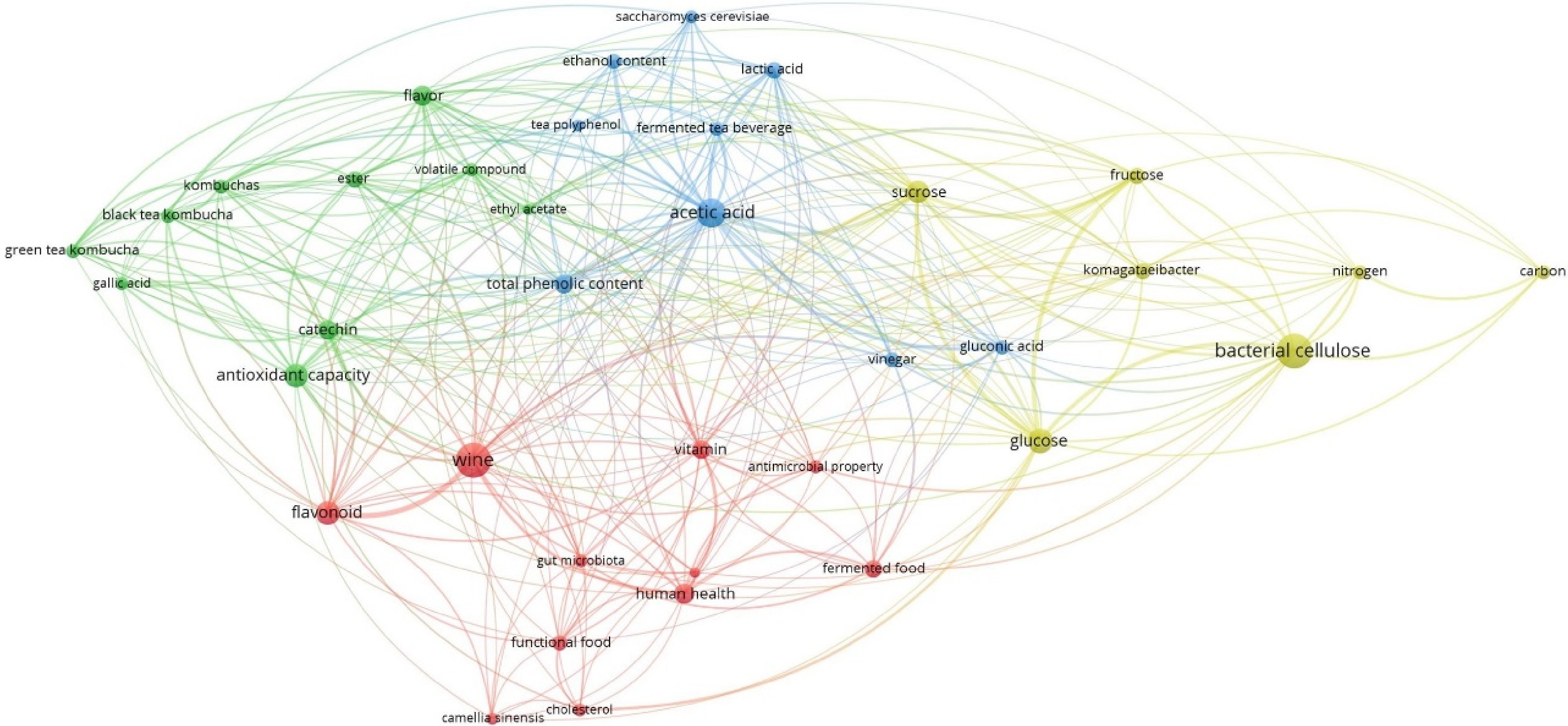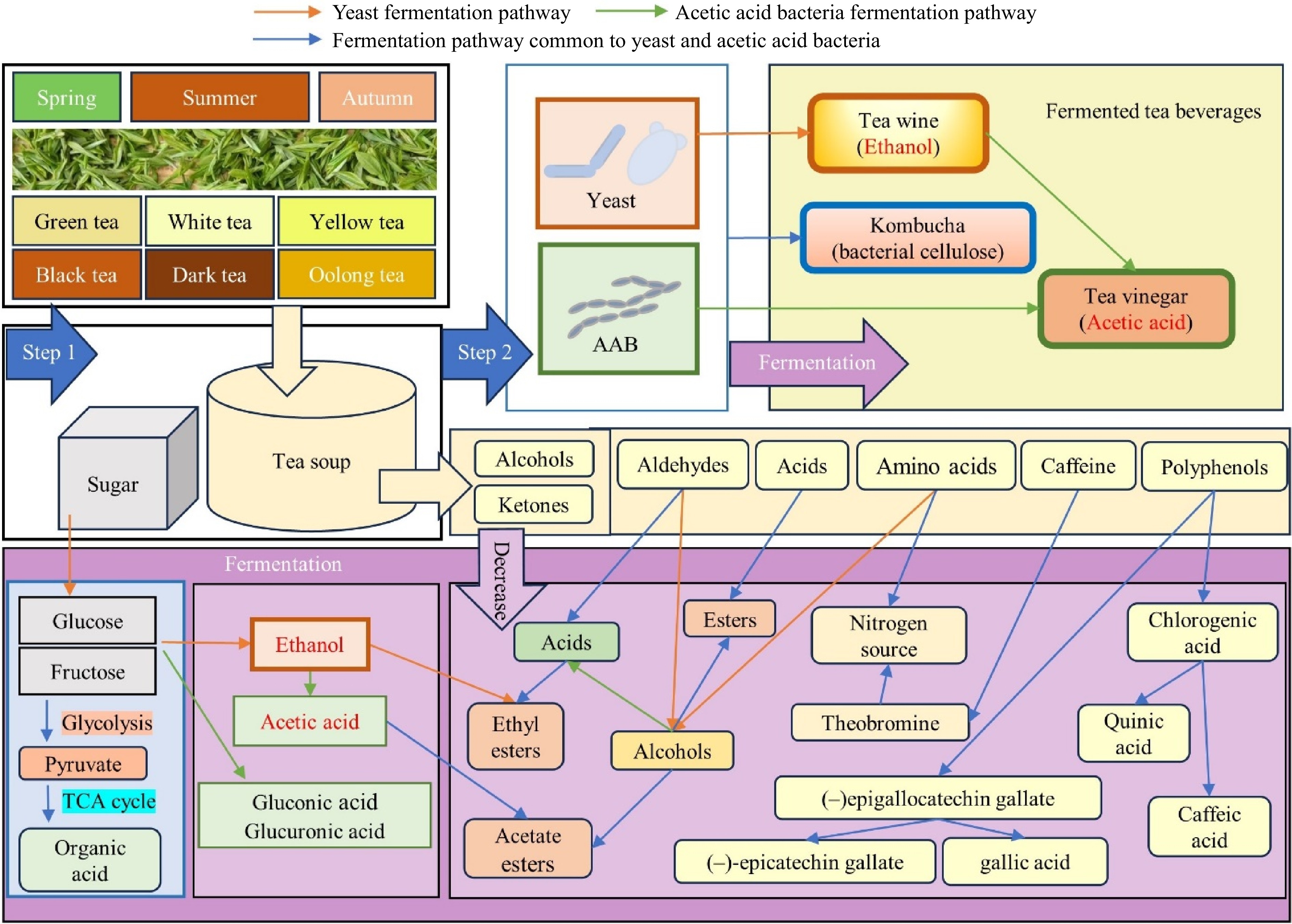-

Figure 1.
Co-occurrence analysis of data from Web of Science on 'Kombucha, tea wine, and tea vinegar' records.
-

Figure 2.
Fermentation processes in tea beverages: from raw materials to finished products. (1) In the production of kombucha, tea wine, and tea vinegar, commonly used tea leaf raw materials include various types of tea such as green, black, oolong, dark, and white teas, processed differently, as well as seasonally surplus summer tea leaves. (2) These teas provide the substrate for fermentation. For kombucha, sugar tea soup, yeast, and a mix of acetic acid bacteria are added to initiate fermentation. In contrast, the addition of yeast alone ferments into tea wine while combining the ethanol from yeast fermentation with acetic acid bacteria further produces tea vinegar[16]. (3) During fermentation, glucose and fructose are converted into ethanol by yeast and transformed into gluconic and glucuronic acid by acetic acid bacteria. Additionally, ethanol is oxidized to acetic acid[14,27]. Throughout the microbial metabolism process, various compounds such as alcohols, ketones, aldehydes, acids, amino acids, caffeine, and polyphenols in the tea undergo transformations, being preserved, increased, or decreased. Caffeine is converted into theobromine and theophylline, serving as nitrogen sources for the microbes. Amino acids provide nitrogen and are transformed into alcohols, while aldehydes convert into alcohols and acids. Reactions between alcohols and acids with ethanol and acetic acid result in the formation of new ethyl esters and acetate compounds[15,30,31,33,35,55,72]. Tea polyphenols, predominantly flavonoids, and phenolic acids[67], undergo significant changes: catechin ester bonds break, (–)epigallocatechin gallate hydrolyzes into epigallocatechin and gallic acid, and chlorogenic acid converts into caffeic acid and quinic acid[19]. This intricate fermentation process not only alters the chemical composition of the raw materials but also enhances the flavor and nutritional value of the final products, underscoring the uniqueness and complexity of tea beverage fermentation.
-
Beverage Fermentation conditions Substrate Results Ref. Kombucha 3% (w/v) SCOBY,
100 mL/L kombucha,
fermented at 25 °C for 10 d.Green tea pH = 3.2, total acid: 0.36% (w/v acetic acid), alcohol: 7.29 g/L,
total phenols: 0.70 mg GAE/mL, theaflavin: 0.028 (% w/v),
theobromine: 1.330 (% w/v).[30] Black tea pH = 3.5, total acid: 0.32% (w/v acetic acid), alcohol: 4.90 g/L,
total phenol: 1.09 mg GAE/mL, theaflavin: 0.151 (% w/v), theobromine: 1.998 (% w/v).Kombucha 30 g SCOBY, 100 mL kombucha, fermented at 27 °C for 14 d. Black tea Days 7 and 14 of fermentation: acetic acid: 3.18, 9.18 (mg/mL),
Alcohol: 4.69, 5.83(mg/mL).
Days 0, 7 and 14 of fermentation:
polyphenolics: 79.38, 64.81, 67.20 (mg/g DW),
flavonoids: 17.97, 14.46, 13.87 (mg/g DW), and
total catechins: 2.184 ,0.99, 0.464 (mg/g DW).[33] Green tea Days 7 and 14 of fermentation: acetic acid: 4.22, 7.65 (mg/mL),
alcohol: 2.81, 4.18 (mg/mL).
Days 0, 7 and 14 of fermentation:
polyphenolic compounds: 74.40, 100.33, 67.40 (mg/g DW),
flavonoids: 16.57, 18.49, 15.11 (mg/g DW),
total catechins: 18.253, 9.770, 11.844 (mg/g DW).Kombucha 10% SCOBY and kombucha,
28 ° C fermented for 1, 7, 14 d.Green tea Tea soup: pH = 5.54, alcohol: 0, acidity: 20.12 (mg acetic acid/L),
TFC: 254.1 (mg/L), TPC: 269.0 (mg/L).
At 1, 7, 14 d fermentation:
pH = 3.50, 2.61, 2.49, alcohol: 0.2%, 3.0%, 2.75%,
acidity: 610.34, 7,039.21, 9,147.4 (mg acetic acid/L),
TFC: 196.2, 146.8, 181.3 (mg/L), TPC: 277.6, 299.6, 320.1 (mg/L).[29] Black tea Tea soup: pH = 5.34, Alcohol: 0, acidity: 23.5 (mg acetic acid/L),
TFC: 231.7 (mg/L), TPC:183.1 (mg/L),
At 1, 7, 14 d fermentation: pH = 3.54, 2.62, 2.53,
Saccharose: 10.88, 9.5, 7.5 (Brix-g/100 mL),
alcohol: 0.3%, 3.25%, 2.0%,
acidity: 501.02, 7,039.08, 9,083.03 (mg acetic acid/L),
TFC: 149.1, 90.5, 126.7 (mg/L), TPC: 201.0, 219.5, 206.0 (mg/L).White tea Tea soup: pH = 6.53, alcohol: 0, acidity: 21.09 (mg acetic acid/L)
TFC: 209.3 (mg/L), TPC: 184.6 (mg/L);
At 1, 7, 14 d fermentation: pH = 3.56, 2.53, 2.37,
saccharose: 10.13, 10.13, 9.5 (°Brix-g/100 mL),
alcohol: 0.4%, 3.5%, 3.0%,
acidity: 620.13, 7,048.06, 9,132.20 (mg acetic acid/L)
TFC: 132.6 (mg/L), 83.8 (mg/L),111.6 (mg/L),
TPC: 200.8 (mg/L), 205.6 (mg/L), 228.1 (mg/L).Pu'er tea Tea soup: pH = 5.58, alcohol: 0, acidity: 20.42 (mg acetic acid/L),
TFC: 359.9 (mg/L), TPC: 229.5 (mg/L),
At 1, 7, 14 d fermentation: pH = 3.62, 2.38, and 2.32,
alcohol: 0.4%, 3.5%, 3.0%,
acidity: 600.09, 7,059.47, 9,071.02 (mg acetic acid/L),
TFC: 292.5, 198.1, 242.5 (mg/L), TPC: 219.8, 270.5, 271.9 (mg/L).Kombucha 10% (v/v) kombucha, fermented at room temperature for 15 d. Green tea pH = 2.94, total acid: 11.72 g/L,
alcohol free, glucuronic acid: 1.37 g/L, gluconic acid: 41.42 g/L, DSL: 3.44 g/L, ascorbic acid: 0.61 g/L, acetic acid: 10.42 g/L, succinic acid: none.[35] Black tea pH = 2.70, total acid: 16.75 g/L,
alcohol free, glucuronic acid: 1.58 g/L, gluconic acid: 70.11 g/L, DSL: 5.23 g/L, ascorbic acid: 0.70 g/L, acetic acid: 11.15 g/L, succinic acid: 3.05 g/L.Oolong tea pH = 2.89, Total acid: 12.24 g/L, no alcohol,
glucuronic acid: 0.07 g/L, gluconic acid: 48.75 g/L, DSL: 4.02 g/L, ascorbic acid: 0.60 g/L, acetic acid: 10.48 g/L, succinic acid: none.Tea wine 25°Brix, 0.5% yeast,
fermentation at 25 °C.Black tea Alcohol 14.0% vol, theanine content: 0.241 mg/mL. [38] Tea wine The sugar level was 17 °Bx, 0.3 % yeast, fermentation at 24 °C for 13 d. Green tea The alcohol content was 8.5 %vol, the concentration of tea polyphenols was 2,902.35 mg/L. [36] Tea vinegar 4% alcohol by total volume, 5% acetic acid strain, 30 °C for 9 d. Black tea Theaflavins were significantly decreased, thearubigins were decreased, and theabrownines were increased. [22] Tea vinegar 0.9% yeast, initial sugar 15%. The initial alcohol content was 6% vol,
9% acetic acid bacteria, fermentation at 28 °C for 12 d.Summer and
fall green
tea fragmentsThe acidity content was 59.10 g/L, tea polyphenol content was 2.95 g/L, alcohol content was 0.08% vol, amino acid nitrogen content was 0.14 g/dL, and caffeine content was 0.80%. [72] GAE: Gallic acid equivalent, DW: Dry Weight, TPC: total polyphenols content, TFC: total flavonoids content. Table 1.
Kombucha, tea wine, and tea vinegar prepared from different types of tea.
-
Model Intervention and dosage Significant results and biological activity Ref. Glycemic index and insulin index after a standard carbohydrate meal Sample: 11 healthy adults (four males and seven females),
Period: 120 min after test meals
Group 1: 330 ml of soda water;
Group 2: diet lemonade soft drink;
Group 3: organic kombucha.
Additional capillary blood samples were collected at regular intervals
(15, 30, 45, 60, 90, and 120 min) after commencement of the reference solution or test meal.Soda water (GI: 86 and II: 85)
soft drink (GI: 84 and II: 81)
kombucha (GI: 68, and II: 70)
↓GI (Glycemic index)
↓II (insulin index).[92] HFHF Sample: 40 wistar rats,
Period: 10 weeks,
n = 10 for all groups, ad libitum consume,
Group 1: standard diet (AIN-93M);
Group 2: high-fat and high-fructose diet (HFHF);
Group 3: HFHF + GTK diluted in water (30% v/v);
Group 4: HFHF + BTK diluted in water (30% v/v).GTK, BTK: ↑propionic acid
↑Firmicutes: Bacteroidetes,
↑Erysipelotrichaceae,
↓Bacteroidaceae ,
↓S24-7, Desulfovibrionaceae.
GTK: ↓Proteobacteria.
BTK: ↑Euryarchaeota, Lachnospiraceae.[93] HFHF Sample: 32 wistar rats,
Period: 10 weeks, ad libitum consume,
Group 1: AIN-93M: standard diet (n = 8);
Group 2: HFHF (n = 24);
then regroup as follows: HFHF; HFHF + GTK diluted in water (30% v/v);
HFHF + BTK diluted in water (30% v/v).GTK, BTK: improving the insulin sensitivity, reduced the percentage of lipid vesicles in the liver, reverting the liver steatosis from grade 2 to 1, active CPT1 express,
↑glucose tolerance, TAC in plasma and liver, SOD and CAT in liver,
↓ALT, NO, NLR,
GTK: ↑ADIPO-R2, BTK: ↑SREBP1c.[94] LPS-induced sepsis Sample: Specific pathogen-free C57BL/6 adult mice,
Period: 60 d,
n = 10 per group, with equal numbers of male and female.
Group 1: free-drinking water, the sham;
Group 2: free-drinking kombucha (FD), (replaced every 2 d);
Group 3: intragastric administration (IA) of kombucha (100 μL/100 g daily);
Group 4: free-drinking water, LPS-induced sepsis (LPS);
Group 5: FD + LPS;
Group 6: IA + LPS.
At day 60, Group 1−3 injected phosphate-buffered saline, Group 4−6 injected LPS (20 mg/kg).
Kombucha was added to drinking water at a volume ratio of 1:20.↑CD4+ T cells, B cell, macrophages,
↓CD8+ T cells,
↓IL-1β, TNF-α, CCL-2, IL-10, and CXCL10 in the lung tissues, alleviated the symptoms of lung histopathological damage
↓pIκBα, p-NF-κB expression.
inhibits LPS-induced NF-κB activation.
↓Bacteroidetes,
↑Cyanobacteria and Alistipes,
Prevotellaceae enrich in IA and FD group.[95] High fat high sugar diet injected with Streptozotocin to Type 2 Diabetes Sample: 60 Kunming mice,
Period: day 40 to 68 (4 weeks), randomly divided into five groups ( n = 12). The mice feed with HFHSD was intraperitoneally injected with STZ (50 mg/kg·bw) 4 times (day 28, day 31, day 34 and day 37) to induce T2DM.
Group 1: the normal control (NC), normal diet and gavage administration with 11.1 mL/kg·bw saline;
Group 2: DC, HFHSD and gavage administration with 11.1 mL/kg·bw saline;
Group 3: MET, HFHSD and gavage administration with 0.13 g/kg·bw metformin;
Group 4: KT, HFHSD and gavage administration with 11.1 mL/kg·bw kombucha;
Group 5: tea soup (TS), HFHSD and gavage administration with 11.1 mL/kg·bw tea soup.↓HOMA-IR, ↑HOMA- β, ↓AST, ALT.
↑liver glycogen content,
↓pancreatic index,
↑GPR41/GPR43 mRNA express,
↑GLP-1, PYY,
↑ZO-1, Claudin-1, Occludin,Muc2,
↓IL-1β, IL-6, TFN-α mRNA in intestinal inflammation,
↓LPS, TNF-α and IL-6 in serum.
↑Firmicutes, Lactobacillus, Butyricicoccus, Bifidobacterium,
↓Proteobacteria.
↑acetic acid and butyric acid in SCFAs.[96] NAFLD Sample: 12 male C57BLKS db/db mice,
Group 1: Control, the control diet (n = 4); MCD, the methionine/choline-deficient (MCD) diet (n = 8) for 4 weeks;
Group 2: MCD + water (n = 4);
Group 3: MCD + KT, Kombucha powder 2 g/kg by oral administration,
every 24 h for 3 weeks (n = 4).↓Fat accumulation in the livers.
↓Firmicutes,
↓Erysipelotrichia,
↓Allobaculum,
Turicibacter and Clostridium, ↑Bacteroidetes, ↑Lactobacillus, ↑Mucispirillum.[97] High-fat diet NAFLD Sample: 20 male C57BL/6 mice,
Period: 12 weeks (At the end of the 10th week, for nine consecutive days),
n = 5 for all groups.
Group 1: RC, the control group + tap water;
Group 2: RC + K, control group + kombucha (0.2 mL containing 107–108 microorganisms/mL);
Group 3: HFD, HFD + tap water;
Group 4: HFD + kombucha (HFD + K).Reduced the presence of intra hepatocyte lipid droplets, collagen deposition in the liver's perivascular spaces, and hepatic FXR gene expression. [98] DSS induced the leaky gut syndrome Sample:16 male NMR mice,
Period: day 7 to 21 (14 d);
Old mice: normal group (n = 8); DSS colitis induction group (n = 8): DSS no treatment group and DSS + fKT.
Young mice: normal group (n = 8); DSS colitis induction group (n = 8): DSS no treatment group and DSS + fKT.Ameliorates tissue changes associated with PMNs infiltration, crypt loss, epithelial defects, mucosal destruction, apoptosis, edema, and increased mucosal thinness due to DSS.
↑ZO-1 and ZO-2 express.[99] Table 2.
Healthy benefits of fermented tea beverage kombucha in vivo.
Figures
(2)
Tables
(2)